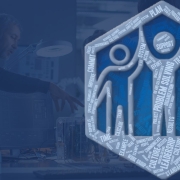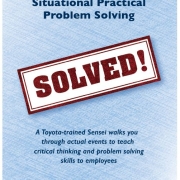The Path to a Problem Solving Culure, Part 1
Part 1 of a series
Problem Solving Training
Those familiar with lean understand that problem solving is inextricably linked to lean’s success. A system that pursues continuous process improvement, like lean, relies upon an effective and reliable problem-solving method, one perfected through countless repeated cycles of learning until “lean” and “problem solving culture” are one in the same thing.
 Reaching this stage requires training, support and discipline. In this post, I’ll review the options available for training and address the challenges in moving from “knows how” to “does.” As consultants we often hear leadership say, “We’ve done problem solving. We’ve trained them how to do it.” When asked what that means, they say, “We provide our people time to solve their problems and expect the problems not to come back. We hear they hold meetings in conference rooms and fill out problem-solving forms on the computer, and we understand that all the stakeholders are there.”
Reaching this stage requires training, support and discipline. In this post, I’ll review the options available for training and address the challenges in moving from “knows how” to “does.” As consultants we often hear leadership say, “We’ve done problem solving. We’ve trained them how to do it.” When asked what that means, they say, “We provide our people time to solve their problems and expect the problems not to come back. We hear they hold meetings in conference rooms and fill out problem-solving forms on the computer, and we understand that all the stakeholders are there.”
Of course, this isn’t the way to train people, let alone support them in a self-sustaining problem solving culture. So the first step is to examine the available training options.
1. On-line Training
Online training has made significant improvements in the last decade; e-learning courses can transfer problem solving knowledge on demand with easy access, minimal risk and relatively low cost. You login, work at your own pace, and take quizzes to confirm your understanding. This can equip you with the rudiments of problem solving methods, but when you return to work, are you prepared to put this knowledge into practice? Unlikely.
What this option misses is on-site learning; the practical importance of “go and see” (observing the problem first hand, from all perspectives). Experiencing the consequences when assumptions are made, standards aren’t followed or results aren’t checked. While on-line training can convey the theory, it can’t convey the experience of a teaching moment. Experiential learning is more deeply imprinted, and on-site teaching can be spontaneous and responsive, like finding other ways to convey concepts when students don’t understand.
2. Problem-solving Workshops
A second option is workshops, a common way to introduce problem solving to an organization. Typically, when something triggers leadership’s awareness of the need, consulting or training firms are engaged to provide a crash course, on or off site. It is more costly than on-line training and requires pre-scheduled time away from day-to-day responsibilities, but it provides a higher level of interaction and responsiveness to the needs of the participants.
This option also provides a greater degree of first-hand experience. Skilled instructors with a history of solving real-world problems can more easily close participants’ gaps between knowledge and understanding. When they struggle to grasp concepts, instructors can dispel misconceptions with probative dialogue, case studies, role-playing or even working on the students’ own, current problems. And this learning takes place in a controlled environment, removed from any employer’s judgment.
But what happens when the workshop ends? Participants return to their jobs with some knowledge, limited experience, and a likely expectation that they can use their newly acquired skills to solve any problem. However, it is here they begin to understand that mastering problem solving methods requires practice and time. Closing the gap between knowing something and doing it, and doing it well, requires motivation, expert guidance, and repetition over time until behavior becomes habit.
3. Problem-solving Coach
A third option, often coupled with the first or second, is to engage an experienced problem-solving coach. The coach, periodically on-site for a period of time, not only trains and teaches, but also responds to the specific problems of the organization, offers guidance and reinforces lessons learned so that those receiving help can move from just “knowing” to “doing” as a matter of course. In addition, the coach raises the level of accountability through their on-going presence with a clear set of performance expectations. While initially, this option is the more costly of the three, it is also has the greatest potential for return because it can install the mechanism for continual and effective problem solving activities.
While each of these training options has benefits, and combining them only raises their collective value, training alone will not result in a problem solving culture. The missing element is leadership, and in this context, it means a set of actions that champion communication, transparency and discipline in a blame-free environment. My next post will explore this element of leadership, and how it supports training and together they move an organization on the path toward a problem solving culture.









